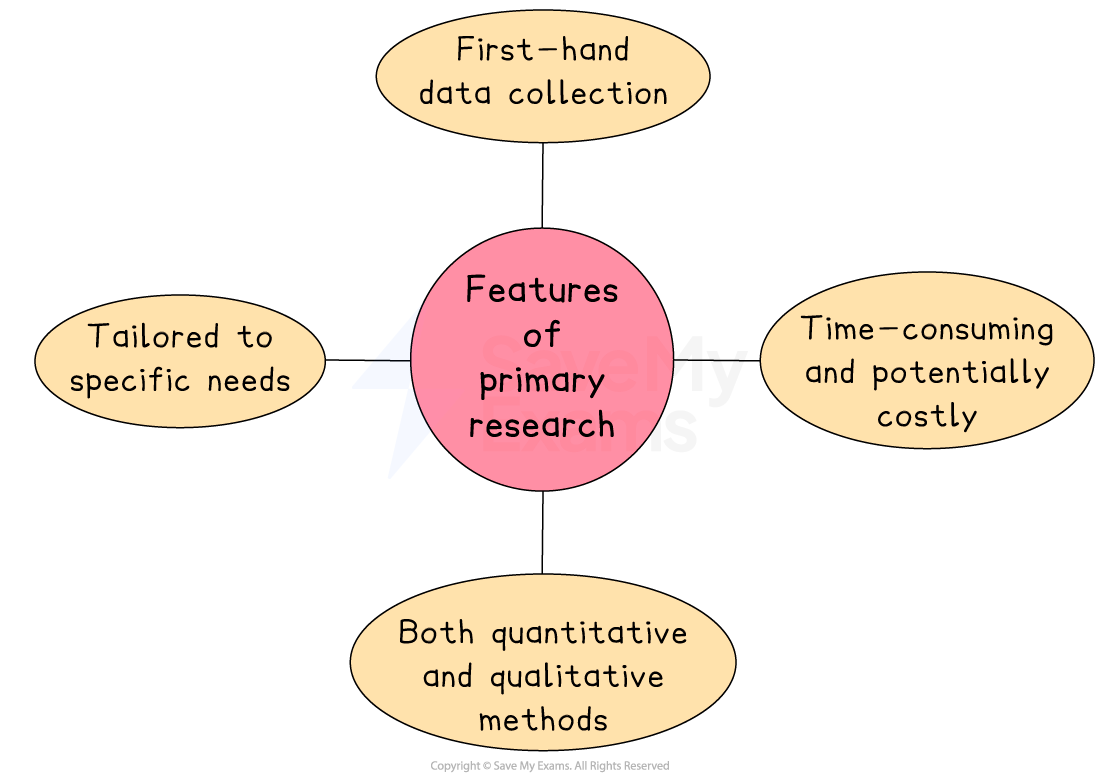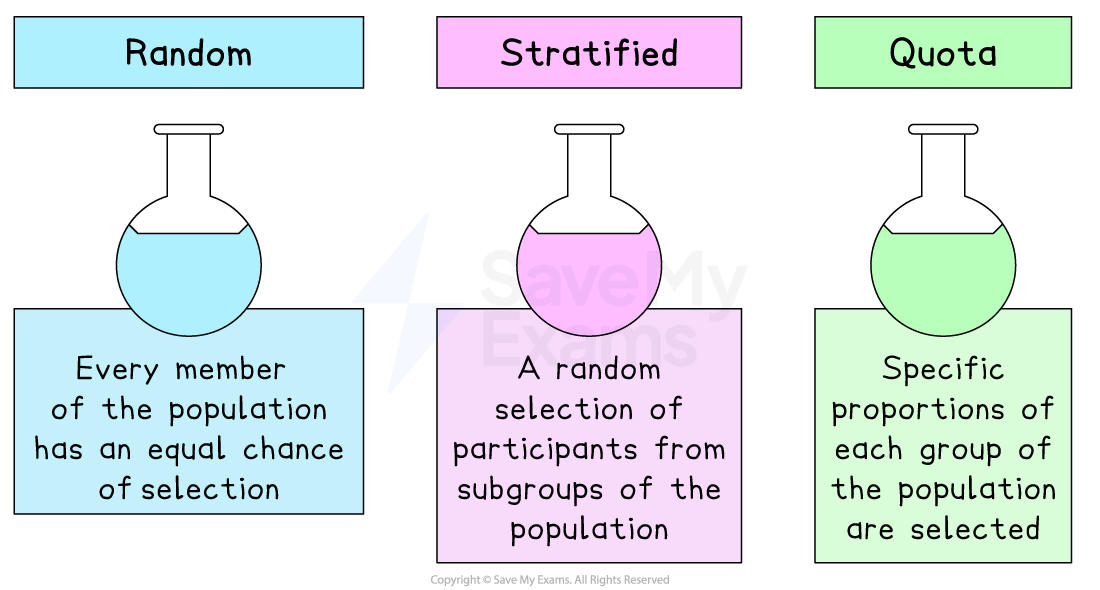Primary Research and Secondary Research (Cambridge (CIE) A Level Business): Revision Note
Exam code: 9609
The features of primary and secondary research
Primary research
Primary research is the process of gathering information directly from consumers in the target market using field research methods such as surveys and interviews
Common features of primary research

First-hand data collection
Primary research involves gathering new information directly from people, rather than using existing sources
Tailored to specific needs
The questions and methods are designed to collect information that is directly relevant to the business’s goals
E.g. A restaurant could ask customers what new dishes they’d like added to the menu
Time-consuming and potentially costly
Collecting and analysing primary data takes time, money, and effort, especially for large samples
E.g. Organising focus groups or conducting interviews may require trained staff and payment to participants
Includes both quantitative and qualitative methods
Primary research can gather numerical data (quantitative) or opinions and attitudes (qualitative)
E.g. A business may run a questionnaire with rating scales and follow-up interviews for deeper insight
Secondary research
Secondary research involves the collection, compilation and analysis of data that already exists
It is likely to have been collected for a broad purpose by another organisation, such as the government or a research specialist
Since the data is already available, it’s usually faster and often cheaper to access than primary research
E.g. downloading a report on consumer habits from a trade organisation's website may be free or low-cost
Usefulness of primary market research data
Businesses can choose from a range of primary marketing research methods and may combine a selection of methods to obtain comprehensive first-hand data

Surveys
The most widely used method for gathering primary research data is sampling through surveys
A series of questions are posed to a certain number of people (respondents)
The results from the "sample" are used to make inferences, which tare extrapolated to be true for the wider population
Advantages | Disadvantages |
|---|---|
|
|
Observation
This involves hiring someone to stand in an appropriate location and study consumer behaviour in a store or perhaps judge the potential consumer traffic at a particular location
Researchers may observe the impact of packaging or the particular placement of a product in a store on consumer choice
Advantages | Disadvantages |
|---|---|
|
|
Interviews
The questions may be set up in a very similar way to a survey; however, an interviewer asks the questions
This method takes longer, but it does allow the interviewee to ask follow-up questions and gather information that might easily be missed when conducting surveys
Advantages | Disadvantages |
|---|---|
|
|
Test marketing
Free samples are provided to the target market for a limited period to gauge their response to the product
Adjustments to the product or other elements of the marketing mix can be made following feedback
Advantages | Disadvantages |
|---|---|
|
|
Focus groups
A marketing specialist leads free-form discussions to collect detailed feedback from the target market on all aspects of the marketing mix
Usually limited to a small group of 12–15 people
The group typically meets for 90 minutes to 3 hours
Advantages | Disadvantages |
|---|---|
|
|
Businesses must choose a primary marketing research method that allows them to capture the correct form of data that can support decision-making
Each method has a range of advantages and disadvantages, which must be considered when making this choice
Evaluation of primary marketing research
Advantages | Disadvantages |
|---|---|
|
|
|
|
|
|
Sampling
Sampling involves getting opinions from a selected group of people in order to find out about the market as a whole
It is expensive and time-consuming to collect data from all customers in a market
Marketing researchers use carefully designed sampling methods from which conclusions can be drawn about the market as a whole
In general, the larger the sample size, the more likely that results from marketing research activities will reflect the market as a whole
The main sampling methods: random, stratified and quota

Random sampling
This method ensures that every member of the population has an equal chance of selection
E.g. a survey of gym members may be sent to a random selection of customers taken from the membership database
Stratified sampling
This method involves the random selection of participants from subgroups of the population, such as age, gender, income level or education groups
E.g. a survey of school pupils may be carried out only on Year 10 girls
Quota sampling
This method obtains a representative sample by determining specific proportions of each group of the population upon which to carry out research
E.g. a researcher conducting a survey for a family car manufacturer may seek to interview a sample comprising 25% of individuals aged 18–24, 50% aged 25–45 and 25% aged 46 and above
The choice of sampling method
The choice of sampling method will depend upon a wide range of factors
Time available
Where little time is available to carry out marketing research, a random sample may be most appropriate, as it is usually very quick and straightforward to organise
Knowledge of the target population
Where a business has good knowledge of the target population, a quota sample should provide a set of research data that lacks bias
Skills of researchers
Where researchers lack experience or expertise in marketing research, a focused stratified sample is likely to provide a useful set of data that can be easily interpreted
Limitations of sampling
The sample might not reflect the views of the whole target market
If the group chosen for the research is too small or not diverse enough, the results may not represent the wider population
This can lead to incorrect assumptions about customer preferences or behaviour
E.g. If a sportswear company only surveys customers in one city, it may miss preferences in other regions
Sampling can be biased if certain groups are over- or under-represented
When the sample includes too many people from one group and too few from another, the results become unbalanced
This kind of bias can happen by mistake or due to poor sampling methods
E.g. If a technology company surveys only younger people online, it may ignore the views of older customers who shop in-store
Human error can reduce the reliability of the findings
Mistakes in how the sample is selected, how questions are asked, or how responses are recorded can affect the accuracy of the research
E.g. An interviewer may ask leading questions, or a poorly designed questionnaire might confuse participants
Examiner Tips and Tricks
A research population refers to the group of people in whom the business has an interest when conducting marketing research — a common mistake is to assume that research focuses on, say, the whole population of a country or region.
Usefulness of secondary market research data
Sources of secondary research

Source | Explanation |
|---|---|
Government publications |
|
Academic institutions |
|
Industry associations |
|
Marketing research reports |
|
Financial reports |
|
Media sources |
|
Advantages of secondary marketing research
Information is already available and is quicker to collect than primary research, thereby saving time
Information is often free (e.g. government websites and internet sources such as Statista) or cheap to collect, leading to lower costs compared to primary research
Suitable for a small business that lacks a large marketing budget and/or expertise
Disadvantages of secondary marketing research
Information has been collected for other purposes, so it may lack relevance or may not be factually correct, e.g. Wikipedia
Can be expensive to purchase market-specific secondary data from specialist companies, e.g. Mintel reports
Information may be out of date, especially in dynamic markets

Unlock more, it's free!
Did this page help you?